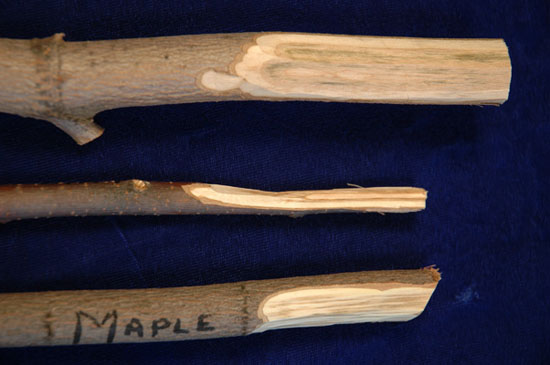Issue 3, May 7, 2010
Problems with Verticillium Wilt?
Many of you have experienced Verticillium wilt first hand. The disease knows no age barrier, killing plants ranging from tomato to mature maples. The fungus causes a tell-tale vascular streaking in the stems and roots of infected plants. To confirm the cause, however, you probably want to have some fresh, symptomatic tissues cultured in a plant lab. Samples with vascular streaking are required. About 10-14 days are needed for the fungus to grow in culture and provide structures for a positive identification. This fungus may survive in the soil for many, many years, so it is important to be sure of what you are trying to manage. Often girdling roots, deep planting, cankers, and other factors can mimic Verticillium wilt. Those problems, however, will not cause vascular staining throughout the plant (see image). You cannot control this disease, but you can manage it. Generally, infected plants do not recover.

Clients often submit tree samples to the University of Illinois Plant Clinic to be tested for the presence of Verticillium. Maple, redbud, and smoketree have been the most common hosts. In recent years magnolia has joined the list of commonly infected species. View a list of hosts in the University of Illinois Report on Plant Disease 1010.
Management is the big issue. Since the fungus remains in the soil, replacement plants must be resistant species. We do not have an effective way to treat landscape sites to kill all pathogens. Heat treatment works on soil that will be used in containers as long as the temperature reaches 130-140 degrees F. Some tips that may help tree health in affected landscapes include maintaining a slightly acidic soil - below 7.0. Start with a soil test to determine the pH in the rooting zone. Hardwood bark mulch helps maintain the slightly lower pH, as do fertilizer amendments such as ammonium sulfate. The amount of fertilizer applied should be dictated by a soil test. It is thought that slightly acidic conditions also allow more bacteria and fungi to compete with Verticillium. In other words, it provides a better environment for natural competition. Balanced fertility, especially nitrogen, phosphorous, and potassium levels, has been shown to be important in Verticillium management. Increased disease levels have been correlated with nitrate sources of nitrogen. None of these tips will eradicate Verticillium from an infected site.--Nancy Pataky
Author:
Nancy Pataky